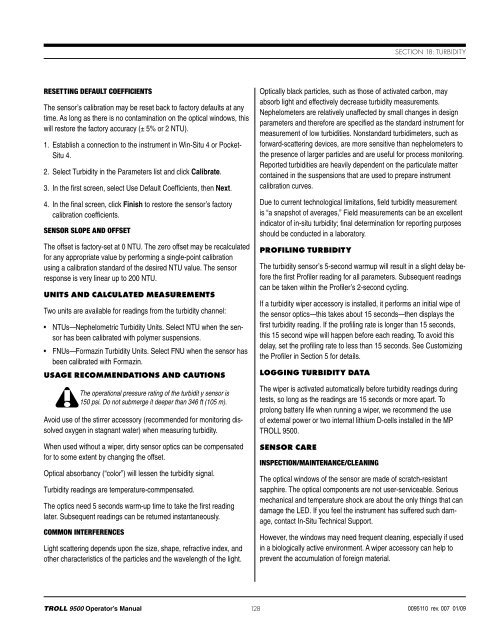TROLL 9500 Operator's Manual - Geotech Environmental Equipment
TROLL 9500 Operator's Manual - Geotech Environmental Equipment
TROLL 9500 Operator's Manual - Geotech Environmental Equipment
Create successful ePaper yourself
Turn your PDF publications into a flip-book with our unique Google optimized e-Paper software.
Section 18: TurbidityResetting Default CoefficientsThe sensor’s calibration may be reset back to factory defaults at anytime. As long as there is no contamination on the optical windows, thiswill restore the factory accuracy (± 5% or 2 NTU).1. Establish a connection to the instrument in Win-Situ 4 or Pocket-Situ 4.2. Select Turbidity in the Parameters list and click Calibrate.3. In the first screen, select Use Default Coefficients, then Next.4. In the final screen, click Finish to restore the sensor’s factorycalibration coefficients.Sensor Slope and OffsetThe offset is factory-set at 0 NTU. The zero offset may be recalculatedfor any appropriate value by performing a single-point calibrationusing a calibration standard of the desired NTU value. The sensorresponse is very linear up to 200 NTU.Units and Calculated MeasurementsTwo units are available for readings from the turbidity channel:• NTUs—Nephelometric Turbidity Units. Select NTU when the sensorhas been calibrated with polymer suspensions.• FNUs—Formazin Turbidity Units. Select FNU when the sensor hasbeen calibrated with Formazin.Usage Recommendations and CautionsThe operational pressure rating of the turbidit y sensor is150 psi. Do not submerge it deeper than 346 ft (105 m).Avoid use of the stirrer accessory (recommended for monitoring dissolvedoxygen in stagnant water) when measuring turbidity.When used without a wiper, dirty sensor optics can be compensatedfor to some extent by changing the offset.Optical absorbancy (“color”) will lessen the turbidity signal.Turbidity readings are temperature-commpensated.The optics need 5 seconds warm-up time to take the first readinglater. Subsequent readings can be returned instantaneously.Common InterferencesLight scattering depends upon the size, shape, refractive index, andother characteristics of the particles and the wavelength of the light.Optically black particles, such as those of activated carbon, mayabsorb light and effectively decrease turbidity measurements.Nephelometers are relatively unaffected by small changes in designparameters and therefore are specified as the standard instrument formeasurement of low turbidities. Nonstandard turbidimeters, such asforward-scattering devices, are more sensitive than nephelometers tothe presence of larger particles and are useful for process monitoring.Reported turbidities are heavily dependent on the particulate mattercontained in the suspensions that are used to prepare instrumentcalibration curves.Due to current technological limitations, field turbidity measurementis “a snapshot of averages,” Field measurements can be an excellentindicator of in-situ turbidity; final determination for reporting purposesshould be conducted in a laboratory.Profiling TurbidityThe turbidity sensor’s 5-second warmup will result in a slight delay beforethe first Profiler reading for all parameters. Subsequent readingscan be taken within the Profiler’s 2-second cycling.If a turbidity wiper accessory is installed, it performs an initial wipe ofthe sensor optics—this takes about 15 seconds—then displays thefirst turbidity reading. If the profiling rate is longer than 15 seconds,this 15 second wipe will happen before each reading. To avoid thisdelay, set the profiling rate to less than 15 seconds. See Customizingthe Profiler in Section 5 for details.Logging Turbidity DataThe wiper is activated automatically before turbidity readings duringtests, so long as the readings are 15 seconds or more apart. Toprolong battery life when running a wiper, we recommend the useof external power or two internal lithium D-cells installed in the MP<strong>TROLL</strong> <strong>9500</strong>.Sensor CareInspection/Maintenance/CleaningThe optical windows of the sensor are made of scratch-resistantsapphire. The optical components are not user-serviceable. Seriousmechanical and temperature shock are about the only things that candamage the LED. If you feel the instrument has suffered such damage,contact In-Situ Technical Support.However, the windows may need frequent cleaning, especially if usedin a biologically active environment. A wiper accessory can help toprevent the accumulation of foreign material.<strong>TROLL</strong> <strong>9500</strong> Operator’s <strong>Manual</strong> 1280095110 rev. 007 01/09
















